| Columns Retired Columns & Blogs |
Weiss Medea D/A processor Measurements
Sidebar 3: Measurements
The hot-running Weiss Medea DAC locked to sample rates from 44.1kHz to 192kHz (the latter using inputs 1 and 2 in parallel), though as Kal noted, its narrow PLL acceptance window means that it takes a long time to lock. With the analog output set to High, the maximum output level at 1kHz was 8.44V from the unbalanced outputs, 16.89V from the balanced. These figures dropped to a more sensible 2.131V and 4.262V, respectively, when the output was set to Low. The DAC didn't invert absolute polarity from either set of outputs—the XLRs are wired with pin 2 hot—and the source impedance was well below 1 ohm.
With CD playback, there was a very slight response rise at the top of the audioband (fig.1, top pair of traces), though I doubt this will be audible. It was not apparent playing back pre-emphasized data (fig.1, lower traces). It was also absent when the Medea decoded data sampled with a 96kHz sample rate (fig.2), the response falling off smoothly above 40kHz. (The apparent rolloff below 10Hz in these graphs is due to the Audio Precision System One, not to the Weiss DAC.) At 192kHz sampling, the response extended to 80kHz before rolling off. Channel separation (not shown) was superb, any crosstalk being buried beneath the noise floor in the midrange. Though separation diminished slightly in the treble—due, presumably, to a small amount of capacitive coupling—it was a still superb 110dB in both directions at 20kHz.
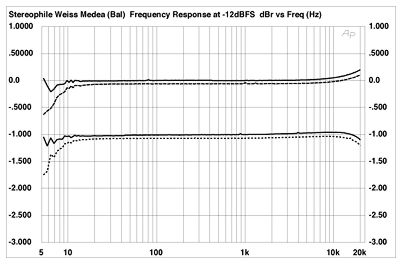
Fig.1 Weiss Medea, balanced, frequency response without (top) and with de-emphasis (bottom), at -12dBFS into 100k ohms (right channel dashed, 0.5dB/vertical div.).
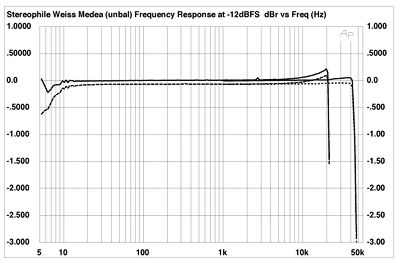
Fig.2 Weiss Medea, unbalanced, frequency response at 44.1kHz (top at 20kHz) and 96kHz sample rates at -12dBFS into 100k ohms (right channel dashed, 0.5dB/vertical div.).
Fig.3 shows spectral analyses of the Medea's analog output while it decoded data representing a dithered 1kHz tone at -90dBFS. The top pair of traces are with 16-bit data—there are no spuriae visible, and the noise floor is actually the dither with which the data have been encoded. Increasing the data word length to 24 bits (lower traces) drops the level of the noise by 20dB. This is one of the best DACs I have measured on this test, and it is the best at low frequencies: almost 20-bit performance is implied, which is superb. This very low audioband noise was also apparent when the Medea decoded 16-bit data representing a 1LSB DC offset (not shown), and although this graph revealed a rise in ultrasonic noise—presumably due to noise-shaping—this peaked at just -93dBFS at 88.2kHz.
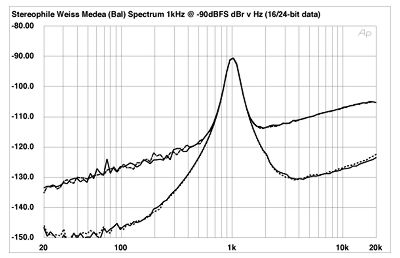
Fig.3 Weiss Medea, balanced, 1/3-octave spectrum of dithered 1kHz tone at -90dBFS, with noise and spuriae, 16-bit (top) and 24-bit data (bottom). (Right channel dashed.)
As expected, the Medea's linearity error with 16-bit data was vanishingly small, to well below -100dBFS (fig.4). As a result of both this superb linearity and the low analog noise floor, the DAC's reproduction of an undithered 16-bit/1kHz sinewave at -90.31dBFS was essentially perfect (fig.5). Increasing the data's bit depth to 24 bits resulted in a pretty good sinewave even without dither (fig.6).
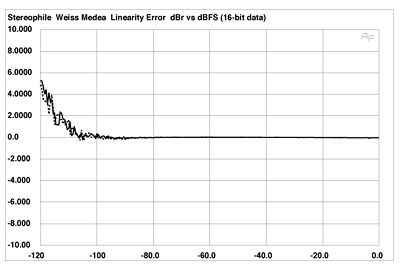
Fig.4 Weiss Medea, departure from linearity, 16-bit data (2dB/vertical div., right channel dashed).
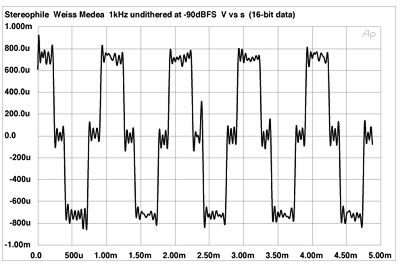
Fig.5 Weiss Medea, waveform of undithered 1kHz sinewave at -90.31dBFS, 16-bit data.
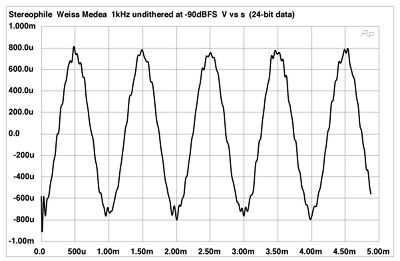
Fig.6 Weiss Medea, waveform of undithered 1kHz sinewave at -90.31dBFS, 24-bit data.
The Medea's output was virtually free from harmonic distortion, even at maximum level into a punishing 600 ohm load (fig.7). The same was true for intermodulation (fig.8), the 1kHz difference component resulting from maximum-level 19kHz and 20kHz tones lying at -106dB (0.0005%).
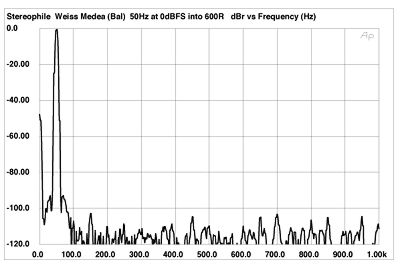
Fig.7 Weiss Medea, balanced, spectrum of 50Hz sinewave, DC-1kHz, at 0dBFS into 600 ohms (linear frequency scale).
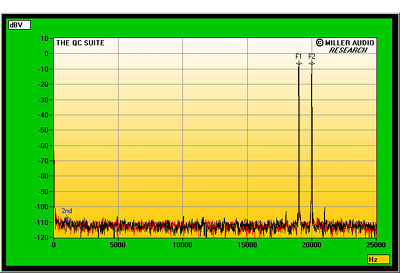
Fig.8 Weiss Medea, unbalanced, HF intermodulation spectrum, DC-25kHz, 19+20kHz at 0dBFS into 8k ohms (linear frequency scale).
I tested the Medea's susceptibility to word-clock jitter using the Miller Audio Research Jitter Analyzer. This drives the DAC with an analytical signal comprising an undithered high-level, high-frequency sinewave at exactly one quarter the sample rate, over which has been overlaid a low-frequency squarewave with a peak level of just 1 LSB. This maximally stresses the DAC's rejection of datalink timing errors. The Analyzer obtains a high-resolution spectrum of the DAC's analog output and searches the FFT bins for symmetrical sidebands around the HF tone.
With the test data generated on a PC and transmitted via a long plastic TosLink optical connection—very much a worst-case situation—the Medea produced just 143.7 picoseconds peak-peak of jitter. This is among the lowest levels I have measured with this setup. Replacing the data source with a PS Audio Lambda CD transport connected by a wider-bandwidth, 6', S/PDIF coaxial link gave very little improvement, showing that the Weiss's input receiver does indeed offer superb jitter rejection. Fig.9 shows the spectrum of the DAC's noise floor for 3.5kHz on either side of the 11.025kHz tone. A pair of sidebands can be seen at ±521Hz (purple "4" markers). I have no idea what these are due to, but they are very low in level. All the other jitter sidebands that can be seen in this graph are data-related (red numeric markers), lying at ±229Hz and its harmonics.
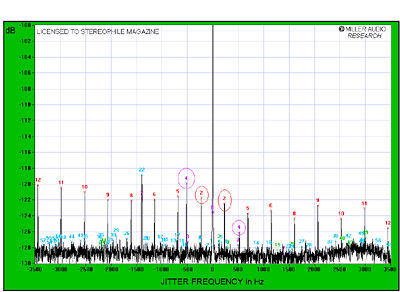
Fig.9 Weiss Medea, unbalanced, high-resolution jitter spectrum of analog output signal, WAV-file playback on PC fitted with RME Digi96/8 PRO soundcard via 15' plastic TosLink (11.025kHz at -6dBFS sampled at 44.1kHz with LSB toggled at 229Hz). Center frequency of trace, 11.025kHz; frequency range, ±3.5kHz.
Having been aware of the superb digital engineering Daniel Weiss has produced for other companies over the years, it came as no surprise to find that the Medea measures so well. In some performance aspects it is among the best I have measured, while in others it is the best. Wow!—John Atkinson
- Log in or register to post comments




































